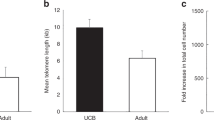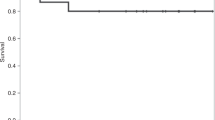Abstract
Umbilical cord blood (UCB) is an attractive stem cell graft option for patients who need allogeneic hematopoietic stem cell support, but lack a suitable HLA-matched donor. However, the limited number of hematopoietic progenitor cells in a single cord blood unit can lead to an increased risk of graft failure, delayed hematological recovery and prolonged immunosuppression, particularly in adult patients. Several strategies to overcome these potential limitations are being evaluated. In this review, we discuss promising ex vivo manipulations to enhance cord blood engraftment capacity such as culture of UCB cells with stimulatory cytokines and growth factors, mesenchymal cells, Notch ligand, copper chelators, prostaglandins, complement components, nicotinamide and CD26/DPPIV inhibitors. All these approaches are now in early clinical trials. However, despite the fact that several cord blood enhancement strategies have resulted in increased numbers of progenitor cells and faster neutrophil recovery, the ability of these techniques to significantly shorten engraftment time and permit the use of cord units with low numbers of total nucleated cells, or accomplish reliable engraftment with a single cord, have yet to be convincingly demonstrated. The ultimate clinical value of ex vivo cord blood expansion or manipulation has not been defined yet, and the current data do not permit predicting which technology will prove to be the optimal strategy. Nevertheless, expectations remain high that eventually ex vivo enhancement will be able to improve clinical outcomes and significantly extend the applicability of UCB transplantation.
This is a preview of subscription content, access via your institution
Access options
Subscribe to this journal
Receive 12 print issues and online access
$259.00 per year
only $21.58 per issue
Buy this article
- Purchase on Springer Link
- Instant access to full article PDF
Prices may be subject to local taxes which are calculated during checkout
Similar content being viewed by others
References
Rocha V, Broxmeyer HE . New approaches for improving engraftment after cord blood transplantation. Biol Blood Marrow Transplant 2010; 16: S126–S132.
Barker JN, Weisdorf DJ, DeFor TE, Blazar BR, McGlave PB, Miller JS et al. Transplantation of 2 partially HLA-matched umbilical cord blood units to enhance engraftment in adults with hematologic malignancy. Blood 2005; 105: 1343–1347.
Sanz J, Boluda JCH, Martín C, González M, Ferrá C, Serrano D et al. Single-unit umbilical cord blood transplantation from unrelated donors in patients with hematological malignancy using busulfan, thiotepa, fludarabine and ATG as myeloablative conditioning regimen. Bone Marrow Transplant 2012; 47: 1287–1293.
Tsagias N, Koliakos I, Lappa M, Karagiannis V, Koliakos GG . Placenta perfusion has hematopoietic and mesenchymal progenitor stem cell potential. Transfusion 2011; 51: 976–985.
Hofmeister CC, Zhang J, Knight KL, Le P, Stiff PJ . Ex vivo expansion of umbilical cord blood stem cells for transplantation: growing knowledge from the hematopoietic niche. Bone Marrow Transplant 2007; 39: 11–23.
Tung SS, Parmar S, Robinson SN, De Lima M, Shpall EJ . Ex vivo expansion of umbilical cord blood for transplantation. Best Pract Res Clin Haematol 2010; 23: 245–257.
Tocci A, Forte L . Mesenchymal stem cell: use and perspectives. Hematol J 2003; 4: 92–96.
Robinson SN, Ng J, Niu T, Yang H, McMannis JD, Karandish S et al. Superior ex vivo cord blood expansion following co-culture with bone marrow-derived mesenchymal stem cells. Bone Marrow Transplant 2006; 37: 359–366.
De Lima M, Robinson S, McMannis J, Alousi AM, Saliba RM, Munsell M et al. Mesenchymal stem cell (msc) based cord blood (CB) expansion (Exp) leads to rapid engraftment of platelets and neutrophils. ASH Ann Meeting Abstracts 2010; 116: 362.
Bigas A, Espinosa L . Hematopoietic stem cells: to be or Notch to be. Blood 2012; 119: 3226–3235.
Varnum-Finney B, Brashem-Stein C, Bernstein ID . Combined effects of Notch signaling and cytokines induce a multiple log increase in precursors with lymphoid and myeloid reconstituting ability. Blood 2003; 101: 1784–1789.
Delaney C, Heimfeld S, Brashem-Stein C, Voorhies H, Manger RL, Bernstein ID . Notch-mediated expansion of human cord blood progenitor cells capable of rapid myeloid reconstitution. Nat Med 2010; 16: 232–236.
Peled T, Landau E, Prus E, Treves AJ, Nagler A, Fibach E . Cellular copper content modulates differentiation and self-renewal in cultures of cord blood-derived CD34+ cells. Br J Haematol 2002; 116: 655–661.
Peled T, Mandel J, Goudsmid RN, Landor C, Hasson N, Harati D et al. Pre-clinical development of cord blood-derived progenitor cell graft expanded ex vivo with cytokines and the polyamine copper chelator tetraethylenepentamine. Cytotherapy 2004; 6: 344–355.
De Lima M, McMannis J, Gee A, Komanduri K, Couriel D, Andersson BS et al. Transplantation of ex vivo expanded cord blood cells using the copper chelator tetraethylenepentamine: a phase I/II clinical trial. Bone Marrow Transplant 2008; 41: 771–778.
Goessling W, North TE, Loewer S, Lord AM, Lee S, Stoick-Cooper CL et al. Genetic interaction of PGE2 and Wnt signaling regulates developmental specification of stem cells and regeneration. Cell 2009; 136: 1136–1147.
Frisch BJ, Porter RL, Gigliotti BJ, Olm-Shipman AJ, Weber JM, O’Keefe RJ et al. In vivo prostaglandin E2 treatment alters the bone marrow microenvironment and preferentially expands short-term hematopoietic stem cells. Blood 2009; 114: 4054–4063.
Hoggatt J, Singh P, Sampath J, Pelus LM . Prostaglandin E2 enhances hematopoietic stem cell homing, survival, and proliferation. Blood 2009; 113: 5444–5455.
Goessling W, Allen RS, Guan X, Jin P, Uchida N, Dovey M et al. Prostaglandin E2 enhances human cord blood stem cell xenotransplants and shows long-term safety in preclinical nonhuman primate transplant models. Cell Stem Cell 2011; 8: 445–458.
Cutler CS, Shoemaker D, Ballen KK, Robbins D, Desponts C, Kao GS et al. FT1050 (16,16-dimethyl prostaglandin E2)-enhanced umbilical cord blood accelerates hematopoietic engraftment after reduced intensity conditioning and double umbilical cord blood transplantation. ASH Ann Meeting Abstracts 2011; 118: 653.
Ratajczak MZ, Reca R, Wysoczynski M, Kucia M, Baran JT, Allendorf DJ et al. Transplantation studies in C3-deficient animals reveal a novel role of the third complement component (C3) in engraftment of bone marrow cells. Leukemia 2004; 18: 1482–1490.
Brunstein CG, McKenna DH, DeFor TE, Sumstad D, Ratajczak M, Laughlin MJ et al. Priming of hematopoietic progenitor cells (HPC) with complement fragment 3 A (C3A) to promote homing of umbilical cord blood (UCB): safety profile. Biol Blood Marrow Transplant 2012; 18: S210.
Denu JM . Vitamin B3 and sirtuin function. Trends Biochem Sci 2005; 30: 479–483.
Peled T, Shoham H, Aschengrau D, Yackoubov D, Frei G, Rosenheimer GN et al. Nicotinamide, a SIRT1 inhibitor, inhibits differentiation and facilitates expansion of hematopoietic progenitor cells with enhanced bone marrow homing and engraftment. Exp Hematol 2012; 40: 342–355.
Campbell TB, Hangoc G, Liu Y, Pollok K, Broxmeyer HE . Inhibition of CD26 in human cord blood CD34+ cells enhances their engraftment of nonobese diabetic/severe combined immunodeficiency mice. Stem Cells Dev 2007; 16: 347–354.
Christopherson KW, Paganessi LA, Napier S, Porecha NK . CD26 inhibition on CD34+ or lineage- human umbilical cord blood donor hematopoietic stem cells/hematopoietic progenitor cells improves long-term engraftment into NOD/SCID/Beta2null immunodeficient mice. Stem Cells Dev 2007; 16: 355–360.
Kelly SS, Sola CB, de Lima M, Shpall E . Ex vivo expansion of cord blood. Bone Marrow Transplant 2009; 44: 673–681.
Shpall EJ, Quinones R, Giller R, Zeng C, Baron AE, Jones RB et al. Transplantation of ex vivo expanded cord blood. Biol Blood Marrow Transplant 2002; 8: 368–376.
De Lima M, McMannis JD, Saliba R, Worth L, Kebriaei P, Popat U et al. Double cord blood transplantation (CBT) with and without ex-vivo expansion (EXP): a randomized controlled study. ASH Ann Meeting Abstracts 2008; 112: 154.
Author information
Authors and Affiliations
Corresponding author
Ethics declarations
Competing interests
The authors declare no conflict of interest.
Rights and permissions
About this article
Cite this article
Norkin, M., Lazarus, H. & Wingard, J. Umbilical cord blood graft enhancement strategies: has the time come to move these into the clinic?. Bone Marrow Transplant 48, 884–889 (2013). https://doi.org/10.1038/bmt.2012.163
Received:
Revised:
Accepted:
Published:
Issue Date:
DOI: https://doi.org/10.1038/bmt.2012.163
Keywords
This article is cited by
-
Reconstruction of bone marrow microenvironment for expansion of hematopoietic stem cells by a histone deacetylase inhibitor
Cytotechnology (2023)
-
One or two umbilical cord blood cell units? Caveat emptor
Bone Marrow Transplantation (2017)
-
Wharton’s Jelly Mesenchymal Stromal Cells as a Feeder Layer for the Ex Vivo Expansion of Hematopoietic Stem and Progenitor Cells: a Review
Stem Cell Reviews and Reports (2017)
-
Characterization of the growth modulatory activities of osteoblast conditioned media on cord blood progenitor cells
Cytotechnology (2016)
-
Umbilical cord blood donation: public or private?
Bone Marrow Transplantation (2015)



